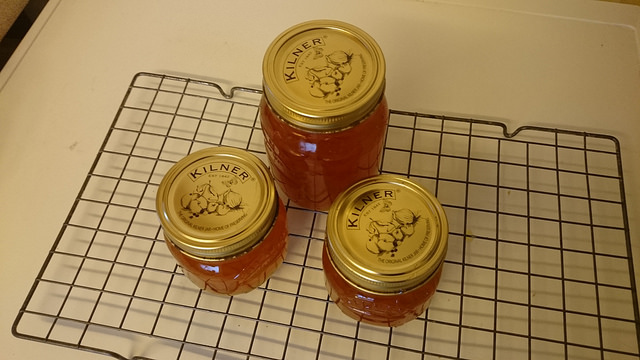Marmalade

This recipe from the BBC is for the whole fruit method. I have chosen this as it seems to give the best setting of the options.
I have added my own notes to the BBC recipe based on some (limited) experience of creating this delicious seasonal product.
How to make marmalade
Note - as most supermarkets sell Seville Oranges in 1kg bags I have scaled back the recipe for that quantity of fruit.
Preparation time 30 mins to 1 hour
Cooking time 1 to 2 hours
Serves Makes 8 jars of marmalade Dietary
Seville oranges are much stronger and more sour than ordinary eating oranges, so they lend a fantastic flavour to this traditional English breakfast treat.
Equipment: You will need eight 300ml/10fl oz clean jam jars with lids and a muslin bag.
By Thane Prince
Ingredients
1kg Seville oranges
1.2kg granulated sugar
Method
1. Scrub the oranges and place the whole fruits in a large stainless steel pan, or preserving pan.
2. Cover with 2.25 litres/4 pints water, then bring to the boil. Reduce the heat and simmer, covered, for about an hour until the fruit is soft.
3. Preheat the oven to 140C/275F/Gas 1. Wash the jars well in warm soapy water then rinse thoroughly under running water. Leave the jars and lids to dry, upside down, in the oven. Place a few saucers in the freezer to chill (these will be used to test if the cooked marmalade has reached setting point).
4. Remove the oranges from the pan with a slotted spoon and set aside to cool. Carefully measure out 1.7 litres/3 pints of the cooking liquid, discarding any extra or topping up with water as necessary. Return the liquid to the pan.
5. When the oranges are cool enough to handle, cut them in half and scoop out the flesh, pith and pips into a bowl. Pour the orange pulp into a muslin bag and secure with kitchen string. Add to the pan.
Note - tie to the pan handle so the muslin bag cannot touch the bottom of the bag. This is to prevent it burning during the rolling boil stage as once it burns it will shed small black particles into your marmalade and ruin it. As double protection from this I rest the bag on a metal spoon in the pan.
6. Chop the peel into shreds as fine as you like and add to the pan. Set the pan over a low heat and add the sugar. Stir until the sugar is dissolved.
Note - unless you like a marmalade that is heavy with peel you should look to only thinly slicing a third to a half max of the oranges. In order to benefit from th pectin you can either add the peel that is left to the muslin bag or add it tot he liquid and take out before bottling.
7. Bring the marmalade to a rolling boil for 1015 minutes. Skim off any orange scum that rises to the surface.
Note - use a jam thermometer and the moment it reaches jam point test for setting using a cold saucer. You are trying for a soft set here for marmalade.
8. Test for setting point by dropping a little of the mixture onto a chilled saucer, leave for a moment, then push your finger into the marmalade. If it wrinkles it is ready. Alternatively, dip a spoon into the marmalade, allow the mixture to cool a little, then slowly pour it back into the pan. If it is at the setting point, the drops will run together to form a hanging flake (this is known as the flake test). It can take up to 30 minutes to reach setting point, so keep testing. 9. When the marmalade is ready, remove the pan from the heat. Carefully ladle into the hot sterilised jars (a sterilised jam funnel makes this much easier) leaving approximately 1cm/½in space at the top of the jar. Twist the lids on the hot jars to seal. The marmalade will continue to thicken up as it cools.